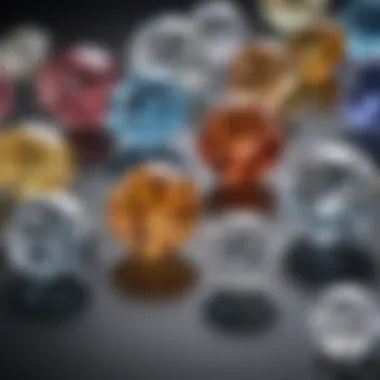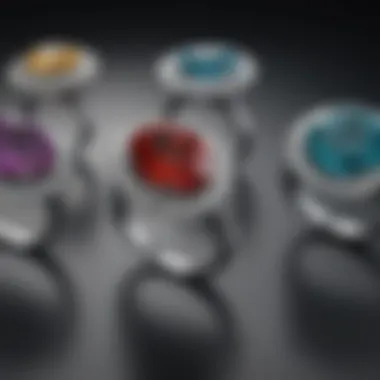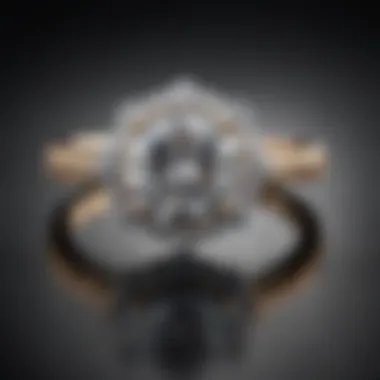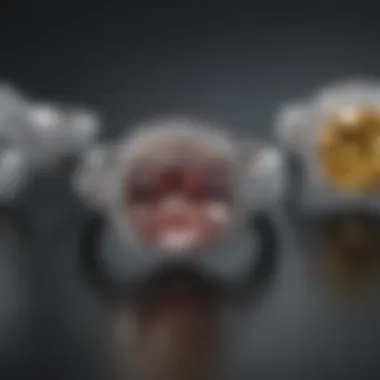Engagement Ring Cuts and Styles: A Complete Guide


Intro
Engagement rings hold a prominent place in jewelry, often representing the deep commitment between partners. Selecting the right ring can be overwhelming, given the variety of cuts, styles, and materials available. A thorough understanding of these elements not only enhances appreciation for the piece but also helps individuals make informed decisions. This guide will delve into the essential aspects of engagement ring cuts and styles, offering valuable insights for both gemstone aficionados and aspiring jewelers.
Gemstone Overview
Definition and Characteristics
Gemstones are naturally occurring minerals or stones, prized for their beauty and rarity. They possess unique characteristics such as hardness, brilliance, and color, making each stone distinct. Diamonds, sapphires, emeralds, and rubies are among the most popular choices for engagement rings. Each has its own hardness rating on the Mohs scale, which measures scratch resistance, and plays a vital role in durability and wearability.
Classification of Gemstones
Gemstones can be categorized broadly into precious and semi-precious stones. Precious stones include diamonds, sapphires, rubies, and emeralds, known for their exceptional quality and value. Semi-precious gemstones like amethyst, garnet, and topaz, while still beautiful, typically carry a lower price tag.
Factors that influence classification include:
- Rarity: How commonly the stone is found.
- Quality: Clarity, color, cut, and carat weight.
- Durability: Resistance to scratches and breakage.
Historical Significance
Ancient Uses and Cultural Importance
Throughout history, gemstones have held significant cultural and spiritual meanings. Civilizations like the Egyptians and Mesopotamians utilized stones not only for adornment but also for protection and healing. Engagement rings, often made from gold or silver, sometimes incorporated stones believed to possess protective qualities.
Myths and Legends Surrounding Gemstones
Many gemstones are steeped in lore. For example, diamonds are often associated with strength and endurance, while sapphires symbolize wisdom and royalty. Such beliefs have shaped preferences and trends in engagement ring styles across ages.
"Gemstones are more than mere adornments; they are imbued with history and significance that can resonate deeply with the wearer."
End
In this guide, we will explore various cuts like round, princess, and oval, delving into their unique attributes and how they influence the overall appeal of engagement rings. Additionally, we will discuss prevailing trends and practical factors to consider when selecting the perfect ring. Understanding these elements will lead to better-informed choices, ensuring the chosen piece reflects the couple's unique story.
Prologue to Engagement Rings
Engagement rings hold a potent significance in personal relationships. More than just a piece of jewelry, they embody commitment and love. Their history spans cultures and centuries, often serving as a cherished symbol of the union between two individuals. In today's market, engagement rings have evolved, becoming a reflection of personal taste and lifestyle.
Choosing an engagement ring involves various considerations. These include the type of gemstone, the cut, the metal, and the style of the setting. Each of these elements plays a critical role in the overall design and appeal of the ring. Understanding the importance of these factors can aid individuals in selecting a piece that resonates with personal values and preferences.
Moreover, engagement rings often hold emotional weight. They may signify key milestones, family heritage, or even individual achievements. Thus, the selection should reflect a meaningful choice that encapsulates the unique bond between partners. In this article, we will explore the intricate details of ring cuts, styles, and current trends, providing a comprehensive guide that helps readers navigate through the complexities of purchasing an engagement ring.
The ensuing sections delve into various engagement ring cuts and their characteristics. By gaining insights into these aspects, gemstone aficionados and collectors can make more informed decisions. The exploration of popular cuts will cover what makes each style distinct and help highlight the care required to maintain their brilliance.
"An engagement ring is not just jewelry, but a promise and a cherished memory for a lifetime."
Attention to detail in the selection process encourages a deeper appreciation of the art of jewelry making. Every choice, from metal type to stone cut, contributes to the creation of a one-of-a-kind ring that will be a constant reminder of love and commitment. This guide promises to enrich your knowledge and support your journey in finding the perfect engagement ring.
Understanding Ring Cuts
The section on understanding ring cuts is crucial in establishing a solid foundation for anyone interested in engagement rings. The term "ring cut" encompasses the techniques used to shape and faceted precious stones, which significantly impacts their appearance and overall quality. Understanding these cuts allows prospective buyers to appreciate the nuances of different styles and what makes each unique.
Moreover, knowing the characteristics and implications of various cuts can aid in making a more informed purchasing decision. It is not solely about aesthetics; the cut can affect how the stone interacts with light, thus enhancing or diminishing its brilliance. In this section, we will delve into specific definitions and the vital role the cut plays in determining gemstone quality, guiding you to a more profound appreciation of these beautiful rings.
Definition of Ring Cuts
A ring cut refers to the geometric shape and proportions that a gemstone takes after it has been fashioned and polished. It is essential to note that the cut is distinct from other attributes, such as color and carat weight. Various shapes, such as round, princess, and emerald, signify specific cuts that create different visual effects.
For example, round cuts are celebrated for their capacity to maximize brilliance, while emerald cuts are renowned for their clarity and luster. Each cut is crafted with unique proportions and facets, which influences not only its look but also how it reflects light. When discussing engagement rings, the cut becomes a primary focal point, as it determines the overall aesthetic appeal and emotional resonance of the piece.
Importance of Cut in Gemstone Quality
The cut of a gemstone plays a pivotal role in its quality and value. It influences several aspects, including:
- Brilliance: How light reflects within the stone. A well-cut gem will dazzle with sparkle and shine.
- Fire: The dispersion of light into color. Higher quality cuts produce more noticeable flashes of color.
- Scintillation: The sparkle effect experienced as the wearer moves the ring. This quality changes with the light entering the gem from various angles.
Investing in a gemstone with an excellent cut means ensuring that you are receiving the best visual impact possible. Without the right cut, even a high-quality stone can appear dull or lifeless. Therefore, understanding these intricacies helps buyers differentiate between mediocre and exceptional pieces, allowing for a purchase that aligns with both aesthetic preferences and budget considerations.


A gemstone's cut is not merely cosmetic. It defines its visual performance and ultimately affects its value in the market.
Popular Engagement Ring Cuts
Understanding the various engagement ring cuts is essential for anyone wishing to invest in a piece of jewelry that represents commitment and individuality. Engagement ring cuts not only affect the overall appearance of the ring but also influence its brilliance, sparkle, and appeal. Different cuts can convey different styles and emotions, making it crucial to choose one that reflects personal aesthetics and values.
Round Cut
Characteristics
The round cut is perhaps the most popular engagement ring cut, known for its exceptional brilliance and light performance. It features a circular shape with 58 facets, designed to maximize sparkle by reflecting light effectively. This cut is versatile and suits various settings, making it a beneficial choice for many couples. Its symmetrical appearance appeals to those who appreciate classic elegance.
Popularity
The round cut has maintained its status as the top choice for engagement rings over several decades. Its widespread acceptance stems from its timeless appeal and ability to complement any metal type or setting style. Many consumers find solace in its proven track record for beauty and quality, ensuring it remains a staple in the jewelry market.
Caring for Round Cut Stones
Caring for round cut stones is relatively straightforward. Regular cleaning with a mild soap solution and a soft brush helps maintain the stone's brilliance. It is essential to avoid harsh chemicals that might dull its shine. As the round cut is durable, it is easily resizable if needed, making it a practical choice for wearers.
Princess Cut
Characteristics
The princess cut is second only to the round cut in popularity. This square-shaped stone features intricate faceting, reflecting light beautifully. Its contemporary design adds a modern touch while still exhibiting significant sparkle. The cut's sharp corners lend it an edgy appearance appealing to many prospective brides.
Popularity
The princess cut has gained significant traction among younger generations. Its modern aesthetic resonates with those favoring unique styles over traditional ones. This cut's impressive light performance and affordability compared to round cuts contribute to its growing prominence.
Caring for Princess Cut Stones
Like the round cut, caring for princess cut stones involves regular cleaning with gentle products. Due to its pointed corners, it is advisable to store it in a protective setting to avoid chipping. Proper care ensures that the brilliance of this cut remains intact over time.
Emerald Cut
Characteristics
The emerald cut exudes sophistication with its large, stepped facets and rectangular shape. This cut showcases the gemstone's clarity rather than sheer sparkles, favoring those who appreciate a subtle beauty. Its unique structure accentuates color and transparency, offering a distinct visual appeal.
Popularity
While not as popular as the round or princess cuts, the emerald cut has a dedicated following. Its association with elegance and vintage styles makes it a desirable choice for those who seek something different. Celebrities often showcase emerald cut rings, which adds to its allure.
Caring for Emerald Cut Stones
Caring for emerald cut stones requires particular attention to prevent scratches on its flat surface. Regular cleaning is still essential, but extra caution should be exercised to avoid hard impacts that may damage its edges. Gentle handling ensures the stone retains its exquisite appearance.
Asscher Cut
Characteristics
The Asscher cut is similar to the emerald cut but is square in shape. It features larger step facets, which creates an appealingly vintage look. The cut's unique structure induces a mesmerizing depth, often described as a "hall of mirrors" effect.
Popularity
This cut has experienced a resurgence in recent years, particularly among those who appreciate retro styles. The Asscher cut is favored for its elegance and historical context. It works well in art deco settings and those seeking a more classic theme.
Caring for Asscher Cut Stones
Proper care for Asscher cut stones is similar to that of emerald cuts. Regular cleaning with mild soap and ensuring proper storage can maintain its beauty. Avoiding harsh chemicals and impacts is critical to preserving the integrity of the facets.
Cushion Cut
Characteristics
The cushion cut combines a square shape with rounded corners, giving it a softer appearance. This cut is known for its larger and more pronounced facets that enhance its brilliance. It offers a vintage feel while remaining versatile enough to suit modern styles.


Popularity
Cushion cuts have gained significant popularity due to their romantic appeal and history. Many appreciate the combined charm of old-world craftsmanship and contemporary style, making the cushion cut an attractive option for engagement rings.
Caring for Cushion Cut Stones
To care for cushion cut stones, regular cleaning and careful storage are needed. The rounded edges make it less prone to chips than sharper cuts, but it is still wise to take precautionary measures. Proper maintenance ensures the stone continues to shine brightly.
Oval Cut
Characteristics
The oval cut is an elongated version of the round cut, offering a distinctive and elegant silhouette. It features similar brilliance to the round cut but provides a unique twist. The oval shape can create the illusion of longer fingers, which appeals to many wearers.
Popularity
The oval cut has gained traction in recent years as couples seek alternative shapes that diverge from traditional norms. Its ability to combine classic features with a contemporary edge makes it an appealing option for engagements.
Caring for Oval Cut Stones
Caring for oval cut stones includes using gentle cleaning methods to maintain their quality. It is crucial to avoid any rough areas or sharp objects to prevent scratches. Regular maintenance ensures they remain stunning.
Marquise Cut
Characteristics
The marquise cut is distinguished by its elongated, boat-shaped appearance. This cut maximizes the stone's size visually, making it a popular choice for those seeking a larger look without increasing carat weight. Its unique form offers versatility when it comes to settings.
Popularity
While marquise cut engagement rings are less common than others, they have a devoted following. This cut appeals to couples looking for something that stands out, often associated with vintage and royal themes. Its regal appearance adds to its charm and desirability.
Caring for Marquise Cut Stones
Caring for marquise cut stones requires careful handling due to the pointed ends. Regular cleaning with appropriate methods and storage in a dedicated case can help to maintain its shape and beauty. Avoiding impact helps prevent chipping.
Radiant Cut
Characteristics
The radiant cut is a hybrid that combines the shapes of the princess and oval cuts. It features a square shape with trimmed corners, offering a unique mix of sparkle and elegance. This cut has numerous facets, allowing for outstanding light reflection.
Popularity
Radiant cuts have gained popularity due to their versatility and aesthetic appeal. They cater to those who appreciate the brilliance associated with both round and square shapes, making them an excellent choice for various tastes.
Caring for Radiant Cut Stones
To care for radiant cut stones, regular gentle cleaning is necessary. The facets make it prone to collecting dust, so regular maintenance ensures they remain radiant. Proper handling is crucial to avoid any chance of scratching.
Heart Cut
Characteristics
The heart cut is a romantic option, symbolizing love and commitment. This cut includes two lobes at the top and a pointed bottom, creating a heart shape. Its unique design attracts those looking for something deeply symbolic and personal.
Popularity
Heart cut stones are not as commonly chosen as other cuts but hold particular meaning for many. Their symbolism of love adds to their charm, making them unique for proposals. Couples seeking a personalized touch often gravitate towards this cut.
Caring for Heart Cut Stones
Caring for heart cut stones involves ensuring the delicate shape remains intact. Regular cleaning and proper storage help preserve their beauty. Due to their unique form, careful handling is vital to preventing any damage.
Secondary Factors Influencing Style
The style of an engagement ring plays a crucial role in complementing the chosen cut and enhancing the overall aesthetic appeal of the piece. Various secondary factors influence this style, including the metal type and setting style. These elements not only affect the visual presentation but also impact durability, maintenance, and personal preferences. Understanding these factors can lead to more informed choices when selecting an engagement ring.


Metal Types
Platinum
Platinum is a preferred metal for engagement rings due to its exceptional qualities. This metal is naturally hypoallergenic and resistant to tarnish, making it ideal for everyday wear. The key characteristic of platinum is its purity; it is commonly found in 95% pure forms, which enhances its durability. This means platinum rings can withstand the test of time and look beautiful for generations. Moreover, platinum has a weighty feel, giving it a luxurious presence on the finger. However, its higher price point may deter some buyers. The potential for scratching exists, yet these can be polished out with relative ease. The unique feature of platinum as a choice for an engagement ring is its ability to showcase gemstones brilliantly due to its reflective quality. Despite its cost, many consider the long-term advantages to outweigh the initial investment.
Gold
Gold has long been a traditional choice for engagement rings, available in various colors, including yellow, white, and rose. The primary allure of gold lies in its timeless appeal and versatility. A significant characteristic is that gold is available in different karats, with 14K and 18K being the most common. This offers buyers a range of choices regarding durability and budget. Gold's warm tones provide an inviting contrast to many gemstones, enhancing their visibility. However, gold is softer than platinum, which means it can scratch more easily. Its unique feature is how it can be alloyed with other metals to create various colors and properties, catering to various tastes. While gold is popular, it may require more maintenance to keep it looking brand new.
Silver
Silver is another metal that some consider for engagement rings. Its affordability makes it appealing, especially to those on a budget. The primary characteristic of silver is its shiny finish and light weight. However, it is generally less durable than gold or platinum. Due to its softness, silver can tarnish over time, which requires regular polishing to maintain its luster. The unique feature of silver is its versatility in styling; it works well with various cuts and styles. Though not as popular for engagement rings as gold or platinum, it appeals to those seeking an alternative look. The trade-off is that silver rings may not last as long as those made from harder metals.
Setting Styles
Solitaire
The solitaire setting is perhaps the most classic choice in engagement ring design. It features a single gemstone held in a simple band, emphasizing the beauty of the stone itself. The key characteristic of this style is its minimalist approach, allowing the diamond or gemstone to take center stage. This simplicity makes it a timeless choice that appeals to many.
One distinct advantage of the solitaire is that it is versatile enough to work with various cuts. However, its simplicity might not suit everyone. Some may seek a more intricate design to symbolize their unique relationship.
Three-Stone
The three-stone setting represents the past, present, and future, making it a meaningful choice for many couples. This style features a center stone flanked by two smaller stones, creating a balanced look. The defining trait of the three-stone setting is its ability to combine different cuts and colors for added visual interest. This ring style appeals to those who value symbolism and the aesthetic appeal of multiple stones. However, it may require more care to maintain the integrity of each stone.
Vintage
Vintage engagement rings refer to styles that evoke a sense of history, whether through intricate designs or old-world charm. The essential characteristic of vintage settings is their detailed craftsmanship and unique designs. These rings appeal to individuals who appreciate history and romance.
A significant advantage of vintage rings is their uniqueness; each ring tells a story. However, sourcing a genuine vintage piece can be more difficult, and sometimes the authenticity verification might pose challenges.
Pavé
The pavé setting features tiny gemstones set closely together, creating a continuous sparkle around the band. This style enhances the center stone and adds a modern touch to engagement rings. The key characteristic of pavé is its brilliance due to the multitude of small stones reflecting light.
Pavé settings often attract those who prefer a more dazzling appearance. The downside is the meticulous care required to keep the tiny stones secure, which may increase maintenance needs over time.
In summary, understanding these secondary factors influencing style allows individuals to select an engagement ring that not only resonates with personal style but also aligns with practical considerations.
Current Trends in Engagement Rings
The engagement ring market has evolved considerably in recent years. Understanding current trends is essential for anyone involved in the selection or design of these rings. This section highlights the significant changes in consumer preferences and values, particularly regarding ethical sourcing, custom designs, and the rise of alternative gemstones. These trends impact not only aesthetics but also the overall meaning of an engagement ring, making them crucial to discuss.
Ethical Sourcing
Ethical sourcing has become a critical topic in the jewelry industry. Consumers are increasingly aware of the origins of the materials used in their rings. They prefer products that are ethically sourced, meaning that gemstones and metals come from mines that prioritize environmental stewardship and fair labor practices. This trend reflects a broader societal movement towards sustainability and responsible consumption.
Choosing ethically sourced diamonds or gemstones can make a significant statement about personal values. Jewelers are responding to this demand by highlighting their sourcing practices. Certifications like the Kimberley Process cover diamonds but also extend to other gemstones like sapphires and emeralds. Understanding where a ring's materials come from is now as meaningful as the ring's design.
Custom Designs
Custom designs have gained immense popularity as more couples seek unique rings that reflect their individual styles. Rather than opting for mass-produced designs, many are now choosing to customize their engagement rings. This not only allows for personalization but also gives couples the opportunity to make design decisions that are significant to them.
Colaboration with jewelry designers can result in truly unique pieces. From selecting specific cuts to incorporating personal engravings, the possibilities are vast. Couples may choose to integrate different metals or alternative gemstones, aligning their choices with their personal stories and preferences. Feedback from customers often indicates that these custom pieces carry a deeper emotional connection than traditional rings.
Alternative Gemstones
The trend towards alternative gemstones is noteworthy. Many couples are now exploring options beyond traditional diamonds. Gemstones such as sapphires, emeralds, and moissanite are becoming increasingly popular due to their unique aesthetic and often lower price point.
Alternative gemstones can present vibrant colors, which may appeal to those wanting a less conventional look. Additionally, these stones can carry various meanings; for instance, sapphires are often associated with loyalty and nobility, while emeralds represent rebirth. Choosing an alternative gemstone thus presents an opportunity to select a stone that resonates on a personal level.
Ultimately, embracing these current trends aligns with a growing desire for rings to not only symbolize love but also reflect personal values and identity.
"The engagement ring has transformed from a simple symbol of commitment to a profound expression of individuality and consciousness."
Epilogue
In this article, we explored the intricate world of engagement ring cuts and styles, uncovering the significance of each element that contributes to a ring’s allure. The concluding section is crucial as it synthesizes the key points, offering a final reflection on the entire discussion.
Choosing an engagement ring is not just about aesthetics. It requires careful consideration of factors such as personal taste, lifestyle, and budget. As evidenced throughout the article, each cut brings its own unique characteristics that cater to different preferences. From the timeless round cut to the unconventional heart cut, understanding these options enhances the decision-making process for potential buyers.
Benefits of a Thoughtful Selection
Investing time in understanding engagement rings can lead to significant advantages:
- Personal Connection: Selecting a ring that resonates with emotional significance is vital.
- Investment Value: Certain cuts and styles may retain more value over time, making them a more prudent choice for the financially savvy.
- Symbolism: Engagement rings hold profound meanings. A carefully chosen ring can reflect the relationship's uniqueness.
Additionally, recognizing current trends—such as ethical sourcing and custom designs—provides insights that align with modern values. As consumers become more conscious, opting for ethically sourced materials or unique designs becomes essential.
It is important to remember that this journey is personal. Each ring tells a story that extends beyond the gemstones and metal. For those in search of the perfect engagement ring, understanding these elements ensures that the selection is not only beautiful but also meaningful. The interplay of cut, style, and personal preference plays an integral role in defining what an engagement ring signifies.
"An engagement ring is not merely about a stone. It represents a promise, a commitment, and a journey ahead."







